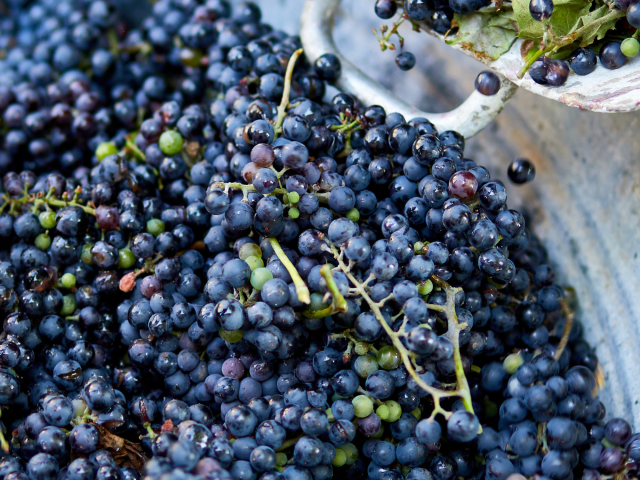Drought and disease see wine production fall to 60-year low
Drought and disease have caused wine production to hit a 60-year low, although a reduced 2023 harvest could help alleviate oversupply due to falling consumption, says the OIV.

According to the International Organisation of Vine and Wine (OIV), based on the information from 29 countries – which account for 94% of global production – the amount of wine made in 2023 is believed to lie between 241.7mhl and 246.6mhl, with a mid-range estimate of 244.1mhl.
This represents a 7% drop compared to the already below-average volume of 2022, and makes 2023 the smallest harvest since 1961, which amounted to 214mhl, said head of the OIV’s statistical department, Giorgio Delgrosso, yesterday.
Speaking via a live link from the OIV’s headquarters in Dijon, Giorgio Delgrosso described the decline in global wine production as “significant”, stressing that this year’s harvest was “even lower than the historically low production of 2017” – when large swathes of Europe saw volumes decimated by severe springtime frosts, and 248mhl of wine was made worldwide.
This year’s much-reduced global harvest total is a reflection of “extreme climatic conditions”, which have led to “major declines” in large wine producing countries in both hemispheres – “with only a few exceptions”, said Delgrosso (such as the US, New Zealand and Germany, see figures, bottom).
Continuing, he said, “Early frost, heavy rainfall and drought have significantly impacted the output of the world’s vineyards.”
He added, “Meteorological anomalies are becoming the new normality, and this is without any doubt one of the most relevant challenges for the wine sector.”
However, Delgrosso pointed out that a smaller harvest in 2023 could help bring wine production back into balance with consumption, which has fallen, leaving unsold stocks of wine in some parts of the world.
Noting that “it is true that in the current complicated economic and geopolitical context, where inflation remains high, global consumption of wine is declining, and stocks are rising in many regions of the world.”
As a result, he commented, “The expected low production of this year could certainly bring equilibrium io the world wine market.”
Turning his attention to the reasons why global wine consumption is decreasing, he said that the worldwide wine market had “faced a series of unprecedented crises,” which he warned would “probably lead to some structural changes in the sector.”
He said, “I am referring to Covid-19 starting in 2020, followed by a global supply chain crisis that started in 2021, and finally the high inflationary pressure that characterised 2022 and to a lesser extent in 2023.”
He added, “The combination of these events resulted in sharp rises in production and distribution costs and generated an overall depressing effect on demand, with consumers all over the world seeing their purchasing power shrinking.”
Finally, he drew attention to a further “two phenomena” that he said “should be be mentioned when analysing wine consumption.”
The first of these “is certain policies related to reducing harmful consumption of alcohol which are certainly shaping new consumption habits in many countries, especially for younger generations,” he said.
As for the second, that concerns the negative impact on wine sales arising from “the strong competition from other alcoholic beverages, especially those with a small alcohol content, such as beer,” according to Delgrosso.
Reproduced below are the highlights from the OIV wine production estimates for global wine production in 2023, which Delgrosso stressed were “preliminary estimates” that exclude musts and grape juices, as well as harvest information from China, which is a major wine producer that has yet to release any figures for the 2023 vintage.
The southern hemisphere:
- The total wine production for the southern hemisphere is estimated to total 45mhl, “which represents a sharp decrease of 19% compared to 2022, and the lowest recorded level of production since 2003”, according to Delgrosso. He added, “This can be attributed to extreme climatic events that took place during the growing season in all major wine producing places.”
- Overall wine production in the southern hemisphere is expected to account for 19% of the world total.
Chile:
- The largest wine producer of the southern hemisphere is Chile with a production of 10mhl – a volume 20% below last year’s “high production”. The harvest was severely affected by wildfires and droughts.
Australia:
- In second place, Australia is recording a decrease of 24% compared to 2022. Delgrosso said, “This is due to the combination of persistent cold temperatures and floods cause the by the effects of La Nina. In addition to this, inventory pressure led to the imposition of yield caps to reduce the oversupply of stocks.”
South Africa:
Partner Content
- Next in terms of size is South Africa, where wine production is estimated at 9.3mhl, which marks decrease of 10% compared to 2022. “This year, the harvest has been affected by fungal disease pressure, particularly powdery and downy mildew,” said Delgrosso.
Argentina:
- In 4th place this year, spring frosts caused significant damage to the vineyards in Argentina, and the harvest is thought to be one of the smallest in its history with estimated production of only 3.3mhl, which represents a decline of 23% over 2022.
New Zealand:
- “Once again, New Zealand represents an exception in the southern hemisphere with a production of 3.6mhl,” said Delgrosso. He added, “It is the only country with positive growth with respect to the average observed in the last 5 years.”
Brazil:
- Brazil has an estimate wine production of 2.3mhl, which is 30% lower than in 2022. “The lack of rain during the growing season has had a significant impact on growing the season,” recorded Delgrosso.
Uruguay:
- Finally, Uruguay, with 500,000hl, is the country in the southern hemisphere that recorded the largest negative variation: minus 34% compared to 2022 “due to a severe drought”.
The northern hemisphere:
The EU:
- The EU accounts for more than 60% of the world’s production, which in 2023 is expected to be 150mhl, which represents a year-on-year decrease of more than 11mhl – as much as 7% lower than in 2022.
- If this estimate is confirmed, this will be the third lowest production since the beginning of the century, only larger than 2017 and 2012 harvests.
- “In the EU in 2023, it is a heterogenous scenario, with very different climatic conditions; in some countries, a rainy spring led to fungal pressure, while storms and hail caused floods and damages to the vineyards,” said Delgrosso. “Especially concentrated in the south of the EU, severe droughts caused hydric stress to the vines. Only a few countries this year saw good climatic conditions which resulted in average or above average harvest volumes.”
France:
- After nine years, in 2023 France is again the first producer in the world with an estimated wine production of 45.8mhl – a level in line with 2022 and 3% above its 5-year average. The harvest can be considered relatively large even though some regions recorded negative variations in respect to last year – this was the case in Bordeaux and the Southwest where an outbreak of downy mildew was reported, and the Languedoc-Roussillon, which was hit by drought.
Italy:
- This year, Italy was the second largest, with an estimated wine production of is 43.9mhl, which is 12 % lower than last year. This is the smallest production since the historically low harvest in 2017. “Many factors can be attributed to this low output, but if I have to pick one, it would certainly be the downy mildew in the central and southern regions,” said Delgrosso.
Spain:
- Spain confirms to be 3rd largest wine producer in the world, with estimated production of 30.7m hl. A Decrease of 14% relative to 2022 and -19% compared to its last five year average. This year, vol is exp to be the lowest in the last 20 years And this is the consequent of a server drought.
Countries in the EU with wine production above 1 mhl:
- On one side, there is positive production in Germany, with 9 mhl, which is plus 1% vs 2022, while Portugal, with 7.4mhl is up 3%; Romania with 4.4m is up 15%, and Hungary with 2.5mhl is up 1%. “In such countries, overall, the growing season was marked by hot and dry conditions, while summer rainfall led to high yields,” said Delgrosso
- On other side there are countries like Austria and Greece that are expecting a decrease in wine production. “Particularly worrying is the situation in Greece”, said Delgrosso, where the expected production of only 1.1mhl is “a consequence of combination of grape diseases – notably downy mildew – and a drought that has severely damaged volumes.” Greece is 44% below 2022 and 50% below a five-year average.
- Meanwhile, Bulgaria and Slovenia are up, but down is Czech Republic and Croatia, with the latter suffering a decrease of 41%, with the harvest volumes almost halved by downy mildew.
Countries outside the EU with wine production above 1 mhl:
The US
- The estimated wine production of the US in 2023 is 25.2mhl, which is 12% higher than 2022, and 4% above the five-year average. “There has been growth due to cool temperatures and heavy winter rains in Napa and Sonoma regions, bringing much needed moisture to the vines after several years of drought,” recorded Delgrosso.
Other countries
- China: figures not available yet.
- Eastern European countries: Russia 4.9mhl, 9% less than the five-year average but in line with 2022.
- Gerogia is 1.5mlh, which is a decline of 28% vs last year, and 19% below its five-year average “due to heavy rainfall, hail and intense winds,” said Delgrosso.
- Moldova is 1.3mhl, down 10%.
- Switzerland has seen a relatively high total in 2023 at 1mhl, which is 4% more than 2022.
Read more
California looks to outstanding vintage for 2023
Cava harvest ‘a warning about the future of viticulture’, says DO president
Our French harvest report for 2023
How the 2023 Champagne harvest fared
Why there’s optimism following difficult harvest in Italy
Italy drops below France for wine production as climate change blamed
Related news
Strong peak trading to boost Naked Wines' year profitability




